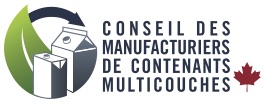Every year, Carton Council of Canada (CCC) publishes the national blended collection-recycling rate for cartons on its website. For 2022, we are pleased to report that this performance now stands at 57%, up from 55% in 2021.
How We Track Performance
The carton performance that we report annually is based on data shared by the various provincial and territorial organizations who operate recycling programs. Some jurisdictions report a recycling rate while others report a collection rate. For this reason, we cannot report a uniform national recycling or collection rate.
The recycling rate refers to the tonnes of cartons sent for recycling (i.e., once they have been sorted and baled at the Material Recovery Facility (MRF) or redeemed through a deposit return system) divided by the tonnes of cartons supplied to market. In contrast, the collection rate refers to the tonnes of cartons collected in the recycling stream and delivered to a MRF divided by the tonnes of cartons supplied to market.
The blended collection-recycling rate is a weighted average of Canada’s thirteen (13) jurisdictions. It is based on the latest available data. The data is compiled, and the calculations are carried out by, a qualified third-party on behalf of CCC.
What explains the increase from 2021?
The national increase is primarily attributable to the increased performance in Ontario. In this province, the recycling performance for printed paper and packaging (PPP) materials including cartons was, until recently, calculated annually by Stewardship Ontario (SO) through its fee schedule. In the 2022 fee schedule it released in October 2021[1], SO determined that the combined recycling rate of gable top and aseptic cartons was 40%. However, this was inconsistent with the results from waste audits conducted by SO/Continuous Improvement Fund (CIF) that estimate the capture rate of cartons (i.e., collection rate) in Ontario is just shy of 70%[2].
The relatively low carton performance in Ontario was attributable to the high proportion of paper laminants (namely hot drink cups and paper-based ice cream containers) in the polycoat bales of municipal programs audited by Stewardship Ontario between 2017 and 2019.
In 2021, CCC carried out its own polycoat composition studies of three large recycling programs that were not part of SO’s dataset. In doing so, we found that paper laminants were not as present in those programs as they were in the programs audited by SO (we found that polycoat bales from the programs we audited had, on average, 90% cartons and only 6% paper laminants, compared to 75% cartons and 22% paper laminants for the programs audited by SO). We calculated the 2022 carton performance by incorporating these new findings, which resulted in a 4% increase of the carton recycling rate in Ontario, and a 2% improvement in the national performance.
Looking Ahead
CCC is committed to continue growing its dataset from Ontario programs and is planning four additional polycoat bale audits over the course of this year. We are also encouraged by the Resource Productivity and Recovery Authority’s recently published numbers[3], which show a growth in the tonnes of polycoat marketed by Ontario municipalities from the previous year (7,685 in 2021 vs 7,210 in 2020).
We are also collaborating with the Continuous Improvement Fund and SO to carryout four-season Curbside, Multi-Residential and Depot Waste Composition Studies (Fall 2022 to Summer 2023). This will result in more granular information pertaining to seven additional carton sub-categories.
Our data gathering and performance measuring efforts are but one of the tactics we activate in order to work towards our goal of 70% blended carton collection-recycling target by 2025. We are continuing to work with schools in Ontario and New Brunswick, and we have forged new partnerships to support schools in BC. We are investing in consumer campaigns in Ontario, BC, Saskatchewan, and the Atlantic Provinces. And these are only a few of the initiatives that we have planned for 2023.
We are also hopeful that the imminent transitions towards full producer responsibility of the country’s two largest Blue Box systems, Quebec and Ontario, will help further improve overall collection and recycling performance.
In the meantime, we are always delighted to hear from stakeholders in the industry. Tell us what you think is needed to raise the carton performance in Canada. We look forward to hearing from you.
[1] This performance is based on 2020 municipal data reported through RPRA’s Datacall.
[2] Based on results of CIF/SO Year 3 (2018/19) Residential Waste Composition Study.
[3] Available at rpra.ca/programs/about-the-datacall, under Datacall Statistics for 2020 and 2021, respectively.


